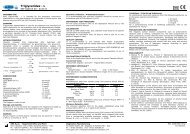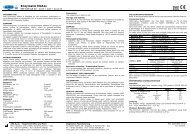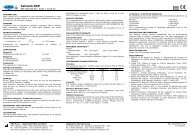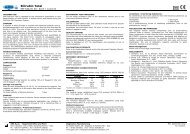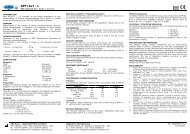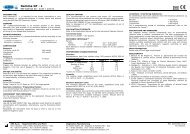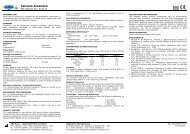You also want an ePaper? Increase the reach of your titles
YUMPU automatically turns print PDFs into web optimized ePapers that Google loves.
<strong>Glicotest</strong> <strong>HbA1c</strong><br />
REF SA5424 00 - 1x30 + 1x9,5 + 1x0,5 ml<br />
INTENDED USE<br />
AMS <strong>Glicotest</strong> <strong>HbA1c</strong> is intended for the quantitative in vitro<br />
determination of haemoglobin A1c in human whole blood using the AMS<br />
Sat-450 Chemistry System.<br />
SUMMARY<br />
Glycohemoglobin is produced by non-enzymatic addition of glucose to<br />
amino groups in hemoglobin. <strong>HbA1c</strong> refers to glucose-modified<br />
hemoglobin A (HbA) specifically at N-terminal valine residues of<br />
hemoglobin beta chains.<br />
This process reflects the average exposure of hemoglobin to glucose<br />
over an extended period.<br />
In diabetic subjects hemoglobin A1c fraction is found to be elevated 2-3<br />
fold over the levels found in normal individuals. Several investigators<br />
have re<strong>com</strong>mended that Hemoglobin A1c serve as an indicator of<br />
metabolic control of the diabetic, since Hemoglobin A1c levels approach<br />
normal values for diabetics in metabolic control; in fact <strong>HbA1c</strong> is a good<br />
indicator of glycemic control in the preceding 2-3 months. <strong>HbA1c</strong> test is<br />
used both as an index of mean glycemia and as measure of risk for the<br />
development of diabetes <strong>com</strong>plications (1-4) .<br />
Currently, the <strong>HbA1c</strong> is re<strong>com</strong>mended for patients with diabetes every<br />
2-3 months as part of the patient Diabetes management program.<br />
METHOD PRINCIPLE<br />
This method utilizes the interaction of antigen and antibody to directly<br />
determine the <strong>HbA1c</strong> in whole blood. Total hemoglobin and <strong>HbA1c</strong> have<br />
the same unspecific absorption rate to latex particles. When mouse<br />
antihuman <strong>HbA1c</strong> monoclonal antibody is added (RB), latex-<strong>HbA1c</strong>mouse<br />
anti human <strong>HbA1c</strong> antibody <strong>com</strong>plex is formed. Agglutination is<br />
formed when goat anti-mouse IgG polyclonal antibody interacts with<br />
the monoclonal antibody. The amount of agglutination is proportional to<br />
the amount of <strong>HbA1c</strong> absorbed on to the surface of latex particles. The<br />
amount of agglutination is measured as absorbance. The <strong>HbA1c</strong> value is<br />
obtained from a calibration curve.<br />
COMPOSITION<br />
Reagent 1<br />
Latex 0.13%<br />
Glycine buffer 20 mmol/l<br />
Reagent 2A<br />
Glycine buffer 80 mmol/l<br />
Reagent 2B<br />
Anti-<strong>HbA1c</strong> 0.05 mg/ml<br />
(Mouse anti-human <strong>HbA1c</strong> monoclonal antibody)<br />
Anti-IgG 0.08 mg/dl<br />
(Goat anti-mouse IgG polyclonal antibody)<br />
Reagent C (lysing reagent)<br />
NaN3<br />
Detergents and stabilizers<br />
< 0.095%<br />
Preparation<br />
The Reagent 1 is ready to use. Prepare the Reagent 2 by adding the<br />
content of one vial of Reagent 2B into one vial of Reagent 2A. Mix well<br />
avoiding foam formation.<br />
Storage and stability<br />
Store at 2-8 °C. Do not freeze the reagents! The reagents are stable up<br />
to the expiry date stated on the label when kept in closed vial.<br />
On board stability: 30 days<br />
SAMPLES<br />
Anti coagulated whole blood.<br />
Hemoglobin A1c in whole blood collected with EDTA is stable for one<br />
week at 2-8 °C. Do not freeze samples! This may lead to a natural<br />
hemolysis. If necessary, store lysed samples at -20 °C instead of whole<br />
blood.<br />
Hemolysate preparation<br />
1. Dispense 1000 µl of hemolysis reagent (Reagent C) into labeled<br />
sample cups. Plastic or glass tubes of appropriate size are<br />
acceptable.<br />
2. Prior to testing, whole blood samples should be mixed by gentle<br />
inversion at least 5 times to resuspend settled erythrocytes.<br />
3. Place 20 µl of well-mixed, fully resuspended whole blood into the<br />
appropriately labeled hemolysis reagent tube. Mix well the solution.<br />
4. Allow to stand for 10 minutes or until <strong>com</strong>plete lysis is evident.<br />
5. Mix well again.<br />
6. The calibrators and controls should be treated exactly as patient<br />
samples.<br />
Specimen collection / Preanalytical factors<br />
It is re<strong>com</strong>mended that specimen collection should be carried out in<br />
accordance with NCCLS protocol H11-A3.<br />
INSTRUMENT TEST PROCEDURE<br />
For the assay procedure refer to the Application Manual and to the<br />
instrument Operator Manual.<br />
CALIBRATION<br />
Use <strong>Glicotest</strong> <strong>HbA1c</strong> Calibrator (REF GD5426 00). See calibrator insert<br />
sheet for lot specific concentration and traceability.<br />
Recalibrate the instrument every 15 days or when a new lot or new<br />
bottle of reagent is used.<br />
QUALITY CONTROL<br />
Normal and abnormal controls such as Enzymatic <strong>HbA1c</strong> Controls (REF<br />
GD5422 00) are re<strong>com</strong>mended. Check that the values obtained are<br />
within the reference range provided<br />
Refer to Westgard et al. (3) for identification and resolution of out of<br />
control situations.<br />
CALCULATION OF RESULTS<br />
Refer to the Application Manual and to the instrument Operator Manual.<br />
Conversion factor<br />
Historically, haemoglobin A1c has been reported as % of total<br />
haemoglobin (notation used by NGSP, JDS/DSCC and Mono-S<br />
standardizations).<br />
Since June 2011, the way <strong>HbA1c</strong> values are reported has switched from<br />
a percendage to a measurement in mmol/mol, due to the introduction<br />
of a new IFCC standardization.<br />
AMS S.p.A. – Registered Office and Plant Diagnostics Manufacturing<br />
Via E. Barsanti 17/A | 00012 Guidonia (Rome) – Italy Via Galileo Galilei, 38 | Seggiano di Pioltello (MI) - Italy<br />
Ph. +39 0774 354441 | Fax +39 0774 578035 Ph. +39 02 929189.1 | Fax +39 02 929189.39<br />
www.ams-analyzers.<strong>com</strong> | info@ams-analyzers.<strong>com</strong> www.gdsrl.<strong>com</strong> | infodiagnostics@ams-analyzers.<strong>com</strong><br />
To make sense of the new units and <strong>com</strong>pare these with old units and<br />
vice versa, apply the below reported equations.<br />
National DCM From IFCC to DCM<br />
NGSP (USA) NGSP = 0.09148 IFCC + 2.152<br />
JDS/JSCC (Japan) JDS = 0.09274 IFCC +1 .724<br />
Mono-S (Sweden) Mono-S = 0.09890 IFCC + 0.884<br />
National DCM From DCM to IFCC<br />
NGSP (USA) IFCC = 10.93 NGSP - 23.50<br />
JDS/JSCC (Japan) IFCC = 10.78 JDS - 18.59<br />
Mono-S (Sweden) IFCC = 10.11 Mono-S - 8.94<br />
REFERENCE INTERVALS (1)<br />
IFCC / DCM<br />
Upper level of nondiabetic<br />
reference<br />
range<br />
Clinical Condition<br />
ADA* target for<br />
patients with<br />
diabetes<br />
IFCC 43 mmol/mol 53 mmol/mol<br />
NGSP 6.1% 7.0%<br />
JDS/JSCC 5.7% 6.6%<br />
Mono-S 5.1% 6.1%<br />
ADA*: American Diabetes Association<br />
Each laboratory should establish reference ranges for its own patients<br />
population.<br />
PERFORMANCE CHARACTERISTICS<br />
Precision<br />
Representative data from studies using CLSI protocol NCCLS EP5-A2<br />
are summarized below.<br />
Control Level 1 Level 2<br />
Number of Observations N 80 80<br />
Number of Runs N 40 40<br />
Mean mmol/mol 78 106<br />
Within Run %CV 1,6 1,3<br />
Total %CV 5,1 3,3<br />
Linearity<br />
The assay is linear within the calibration limits.<br />
Minimum Detection Limit<br />
The minimum detection limit for the assay, established using CLSI<br />
protocol NCCLS EP17-A, is 2.0 mmol/mol (2.3 %).<br />
Method Comparison<br />
Correlation studies were performed using CLSI protocol NCCLS EP9-A2.<br />
Serum results from this assay on Sat-450 were <strong>com</strong>pared with those<br />
from a <strong>com</strong>mercially available analogous system. Results were as<br />
follows: N = 60, y = 1,102x - 8,25 mmol/mol, r = 0,975.<br />
Met. SA542400.0 Eng<br />
Ed. 10/2012
<strong>Glicotest</strong> <strong>HbA1c</strong><br />
REF SA5424 00 - 1x30 + 1x9,5 + 1x0,5 ml<br />
Limitations / Interfering Substances<br />
1. Serum <strong>com</strong>ponents at the following concentrations do not interfere<br />
with this analytical method:<br />
Bilirubin 50 mg/dl<br />
Ascorbic Acid 50 mg/dl<br />
Triglycerides 2000 mg/dl<br />
Carbamylated hemoglobin 7.5 mmol/l<br />
Acetylated hemoglobin 5.0 mmol/l<br />
2. It has been reported that results may be inconsistent in patients<br />
who have the following condition: opiate addiction, lead poisoning,<br />
alcoholism, ingest large doses of aspirin.<br />
It has been reported that elevated levels of HbF may lead to<br />
underestimation of HA1c and that uremia does not interfere with<br />
<strong>HbA1c</strong> determination by immunoassay.<br />
3. It has been reported that Hemoglobin variants HbS and HbA2 are<br />
not detected by immunoassay, leading to possible inaccurate<br />
determination. Also, it has been reported that labile intermediates<br />
(Schiff base) are not detected and do not interfere with <strong>HbA1c</strong><br />
determination by immunoassay.<br />
4. Other very rare variants of hemoglobin (e.g. HbE) have not been<br />
assessed<br />
For a <strong>com</strong>prehensive review of interfering substances, refer to the<br />
publication by Young (2) .<br />
PRECAUTIONS AND WARNINGS<br />
The reagents contain inactive <strong>com</strong>ponents such as preservatives<br />
(Sodium azide or others), surfactants etc. The total concentration of<br />
these <strong>com</strong>ponents is lower than the limits reported by 67/548/EEC and<br />
88/379/EEC directives about classification, packaging and labelling of<br />
dangerous substances. However, the reagents should be handled with<br />
caution, avoiding swallowing and contact with skin, eyes and mucous<br />
membranes. The use of laboratory reagents according to good<br />
laboratory practice is re<strong>com</strong>mended.<br />
Waste Management<br />
Please refer to local legal requirements.<br />
BIBLIOGRAPHY<br />
1. American Diabetes Association (ADA). Clinical practice<br />
re<strong>com</strong>mendation: standards of medical care for patients with<br />
diabetes mellitus. Diab Care 22 (supp): S32-41 (1999).<br />
2. Young D.S., Effects of Drugs on Clinical Laboratory Tests, AACC<br />
Press, Washington, D.C., 1990.<br />
3. Westgard J., and Barry P., Cost- Effective Quality Control:<br />
Managing the Quality and Productivity of Analytical Processes,<br />
AACC Press, Washington, D.C., 1986.<br />
4. Trivelli, L.A., Ranney, H.M. and Lai, H.T., New Eng. J. Med.<br />
284,353 (1971).<br />
5. Gonen. B., and Rubenstein, A.H. Diabetologia 15,1 (1978).<br />
6. Gabbay, K.H., Hasty K., Breslow, J.L., Ellison, R.C., Bunn, H.F.,<br />
and Gallop, P.M., J. Clin. Endocrinol. Metab. 44, 859 (1977).<br />
7. Bates, H.M., Lab.Mang., Vol 16 (Jan 1978).<br />
8. Tietz, N.W., Textbook of Clinical Chemistry, Philadelphia, W.B.<br />
Saunders Company, p.794-795 (1999).<br />
9. Corielo, A., et al., Diabetologia 22, p.379 (1962).<br />
10. Goldstein, D.E., et all. Clin. Chem. 32, pp. 364-370 (1985).<br />
11. Fluckinger, R., et al., Med Intelligence 304 pp. 823-827 (1981).<br />
12. Nathan, D.M., et al., Clin. Chem. 29, pp.466-469 (1983).<br />
13. Engbaek, F., et al. Clin. Chem. 35, pp. 93-97 (1989).<br />
14. American Diabetes Association: Clinical Practice Re<strong>com</strong>mendations<br />
(Position Statement), Diabetes Care 24 (suppl.1): S33-S55,<br />
(2001).<br />
15. NCCLS Document, “Procedures for the collection of arterial<br />
blood specimens”, Approved Standard, 3rd Ed. (1999).<br />
16. EU-Dir 1999/11 Commission Directive of 8 March 1999 adapting to<br />
technical progress the principles of good laboratory practice as<br />
specified in Council Directive 87/18/EEC.<br />
AMS S.p.A. – Registered Office and Plant Diagnostics Manufacturing<br />
Via E. Barsanti 17/A | 00012 Guidonia (Rome) – Italy Via Galileo Galilei, 38 | Seggiano di Pioltello (MI) - Italy<br />
Ph. +39 0774 354441 | Fax +39 0774 578035 Ph. +39 02 929189.1 | Fax +39 02 929189.39<br />
www.ams-analyzers.<strong>com</strong> | info@ams-analyzers.<strong>com</strong> www.gdsrl.<strong>com</strong> | infodiagnostics@ams-analyzers.<strong>com</strong><br />
Met. SA542400.0 Eng<br />
Ed. 10/2012
<strong>Glicotest</strong> <strong>HbA1c</strong><br />
REF SA5424 00 - 1x30 + 1x9,5 + 1x0,5 ml<br />
USO<br />
Il kit AMS <strong>Glicotest</strong> <strong>HbA1c</strong> viene impiegato per la determinazione<br />
quantitative in vitro della emoglobina A1c nel sangue intero umano con<br />
sistema AMS Sat-450.<br />
SOMMARIO<br />
L’emoglobina glicata è prodotta dall’aggiunta non enzimatica di glucosio<br />
ai gruppi amminici presenti nell’emoglobina. La frazione <strong>HbA1c</strong> si<br />
riferisce in modo specifico ai residui N-terminali della valina nelle catene<br />
beta dell’emoglobina A (HbA).<br />
Questo processo riflette l’esposizione media dell’emoglobina al glucosio<br />
nel lungo periodo.<br />
Nei soggetti diabetici la frazione A1c dell’emoglobina è 2-3 volte più<br />
elevata rispetto a soggetti non diabetici. Parecchi studi hanno<br />
dimostrato che il dosaggio dell’emoglobina glicata è un importante<br />
indicatore del controllo metabolico dei diabetici, poiché i livelli di<br />
glicoemoglobina si approssimano a quelli normali in soggetti sotto<br />
controllo metabolico; difatti l’<strong>HbA1c</strong> è un ottimo indicatore del controllo<br />
glicemico nei 2-3 mesi precedenti al dosaggio.<br />
Il dosaggio dell’<strong>HbA1c</strong> è sfruttato sia <strong>com</strong>e indice del valore medio della<br />
glicemia, sia <strong>com</strong>e misura del rischio di insorgenza di <strong>com</strong>plicanze<br />
diabetiche (1-4) .<br />
Allo stato dell’arte, il dosaggio dell’<strong>HbA1c</strong> è rac<strong>com</strong>andato ai pazienti<br />
diabetici ogni 2-3 mesi <strong>com</strong>e parte del protocollo terapeutico.<br />
PRINCIPIO<br />
Questa procedura utilizza una reazione tra antigeni ed anticorpi per<br />
determinare direttamente la concentrazione di <strong>HbA1c</strong> nel sangue intero<br />
emolizzato.<br />
L’emoglobina totale e l’emoglobina glicosilata <strong>HbA1c</strong> si legano alle<br />
particelle di latex alla stessa concentrazione (<strong>com</strong>e rapporto) presente<br />
nell’emolizzato.<br />
Quando alla reazione viene aggiunto il reagente RB, l’anticorpo<br />
monoclonale di topo anti <strong>HbA1c</strong> umana si lega a <strong>HbA1c</strong>.<br />
L’agglutinazione rilevabile strumentalmente si forma quando questo<br />
anticorpo reagisce con l’anticorpo policlonale anti IgG di topo.<br />
L’agglutinazione è proporzionale alla concentrazione di <strong>HbA1c</strong> presente<br />
nel campione ed è misurabile in assorbanza. Attraverso una curva di<br />
calibrazione si ottiene il valore di <strong>HbA1c</strong> del campione.<br />
COMPOSIZIONE<br />
Reagente 1<br />
Lattice 0.13%<br />
Tampone glicina 20 mmol/l<br />
Reagente 2A<br />
Tampone glicina 80 mmol/l<br />
Reagente 2B<br />
Anti-<strong>HbA1c</strong> 0.05 mg/ml<br />
(Anticorpo monoclonale murino anti <strong>HbA1c</strong> umana)<br />
Anti-IgG 0.08 mg/dl<br />
(Anticorpo policlonale di capra anti IgG di topo)<br />
Reagente C (reagente emolizzante)<br />
NaN3<br />
Detergenti e stabilizzanti<br />
< 0.095%<br />
Preparazione<br />
Il reagente 1 è pronto all’uso. Preparare il reagente 2 versando il<br />
contenuto di un flacone di reagente 2B in un flacone di reagente 2A.<br />
Miscelare bene evitando la formazione di schiuma.<br />
Conservazione e Stabilità<br />
Conservare a 2-8 °C. Non congelare i reattivi! I reattivi sono stabili fino<br />
alla data di scadenza riportata in etichetta, se conservati in flacone<br />
chiuso.<br />
Stabilità a bordo dello strumento: 30 giorni<br />
CAMPIONI<br />
Sangue intero anticoagulato.<br />
L’emoglobina A1c in campioni di sangue intero EDTA è stabile per una<br />
settimana a 2-8 °C. Non congelare i campioni! Questo potrebbe<br />
determinare una lisi naturale. Se necessario, conservare i campioni<br />
lisati a -20 °C al posto del sangue intero.<br />
Preparazione dell’emolisato<br />
1. Dispensare 1000 µl di reattivo emolizzante (RC) in coppette porta<br />
campione adeguatamente identificate. Provette di plastica o di vetro<br />
sono accettabili.<br />
2. Prima del dosaggio, i campioni di sangue intero devono essere<br />
miscelati invertendo delicatamente la provetta per almeno 5 volte<br />
per risospendere gli eritrociti sedimentati.<br />
3. Dispensare 20 µl di sangue intero ben miscelato e omogeneo nella<br />
rispettiva coppetta porta campione. Miscelare bene la soluzione.<br />
4. Attendere 10 minuti o fino a che la <strong>com</strong>pleta emolisi sia evidente.<br />
5. Miscelare nuovamente.<br />
6. I calibratori e i controlli devono essere trattati esattamente <strong>com</strong>e i<br />
campioni dei pazienti.<br />
Raccolta dei Campioni / Fattori Preanalitici<br />
Si rac<strong>com</strong>anda di effettuare la raccolta dei campioni in conformità al<br />
Protocollo NCCLS H11-A3.<br />
PROCEDURA DI ANALISI<br />
Per la procedura di analisi fare riferimento all’Application Manual e al<br />
Manuale dell’Operatore dello strumento.<br />
CALIBRAZIONE<br />
Utilizzare <strong>Glicotest</strong> <strong>HbA1c</strong> Calibrator (REF GD5426 00). Riferirsi<br />
all’inserto del calibratore per la concentrazione specifica del lotto e la<br />
tracciabilità.<br />
Ricalibrare lo strumento ogni 15 giorni o quando viene utilizzato un<br />
nuovo lotto o una nuova bottiglia di reagente.<br />
CONTROLLO DI QUALITA’<br />
. Si consiglia l’uso di controlli Normale e Patologico <strong>com</strong>e Enzymatic<br />
<strong>HbA1c</strong> Controls (REF GD5422 00). Verificare che il valore ottenuto sia<br />
all’interno degli intervalli di accettabilità forniti<br />
Far riferimento a Westgard et al. (3) per l’identificazione e la risoluzione<br />
di problematiche legate ai controlli fuori dai limiti.<br />
CALCOLO DEI RISULTATI<br />
Riferirsi all’Application Manual e al Manuale dell’Operatore dello<br />
strumento.<br />
AMS S.p.A. – Sede Legale e Stabilimento Produzione Diagnostici<br />
Via E. Barsanti 17/A | 00012 Guidonia (Roma) – Italia Via Galileo Galilei, 38 | Seggiano di Pioltello (MI) - Italia<br />
Tel. +39 0774 354441 | Fax +39 0774 578035 Tel. +39 02 929189.1 | Fax +39 02 929189.39<br />
www.ams-analyzers.<strong>com</strong> | info@ams-analyzers.<strong>com</strong> www.gdsrl.<strong>com</strong> | infodiagnostics@ams-analyzers.<strong>com</strong><br />
Fattori di Conversione<br />
Storicamente, l’emoglobina A1c veniva riportata <strong>com</strong>e % della<br />
emoglobina totale (notazione adottata dalle standardizzazioni NGSP,<br />
JDS/DSCC e Mono-S).<br />
A partire da giugno 2011, il sistema di espressione dei risultati è<br />
cambiato dalla percentuale alla misura in mmol/mol, a causa<br />
dell’introduzione di una nuova standardizzazione IFCC.<br />
Per potere meglio interpretare i nuovi risultati e confrontare la nuove<br />
unità con quelle vecchie, è necessario applicare le equazioni sotto<br />
riportate.<br />
DCM Da IFCC a DCM<br />
NGSP (USA) NGSP = 0.09148 IFCC + 2.152<br />
JDS/JSCC (Japan) JDS = 0.09274 IFCC +1 .724<br />
Mono-S (Sweden) Mono-S = 0.09890 IFCC + 0.884<br />
DCM Da DCM a IFCC<br />
NGSP (USA) IFCC = 10.93 NGSP - 23.50<br />
JDS/JSCC (Japan) IFCC = 10.78 JDS - 18.59<br />
Mono-S (Sweden) IFCC = 10.11 Mono-S - 8.94<br />
VALORI DI RIFERIMENTO (1)<br />
IFCC / DCM<br />
Estremo superiore<br />
per pazienti non<br />
diabetici<br />
Condizione Clinica<br />
target ADA per<br />
pazienti diabetici<br />
IFCC 43 mmol/mol 53 mmol/mol<br />
NGSP 6.1% 7.0%<br />
JDS/JSCC 5.7% 6.6%<br />
Mono-S 5.1% 6.1%<br />
ADA*: American Diabetes Association<br />
Si rac<strong>com</strong>anda ad ogni laboratorio di stabilire i propri valori normali in<br />
funzione della popolazione su cui opera.<br />
PRESTAZIONI ANALITICHE<br />
Precisione<br />
Dati rappresentativi dello studio secondo il protocollo CLSI NCCLS<br />
EP5-A2 sono sotto riportati.<br />
Controllo Livello 1 Livello 2<br />
Numero di Osservazioni N 80 80<br />
Numero di Prove N 40 40<br />
Media mmol/mol 78 106<br />
Nella Corsa %CV 1,6 1,3<br />
Totale %CV 5,1 3,3<br />
Linearità<br />
Il dosaggio è lineare nell’intervallo di calibrazione.<br />
Limite Minimo di Rivelabilità<br />
Il limite minimo di rilevabilità, stabilito tramite il protocollo CLSI NCCLS<br />
EP17-A, è 2.0 mmol/mol (2.3 %).<br />
Met. SA542400.0 Ita<br />
Ed. 10/2012
<strong>Glicotest</strong> <strong>HbA1c</strong><br />
REF SA5424 00 - 1x30 + 1x9,5 + 1x0,5 ml<br />
Comparazione fra Metodi<br />
Studi di correlazione sono stati effettuati secondo il protocollo CLSI<br />
NCCLS EP9-A2. I risultati dei sieri di questo dosaggio su Sat-450 sono<br />
stati confrontati con un sistema analogo presente in <strong>com</strong>mercio. I<br />
risultati sono stati i seguenti: N = 60, y = 1,102x - 8,25 mmol/mol, r =<br />
0,975.<br />
Limitazioni / Sostanze Interferenti<br />
1. Componenti serici con i seguenti valori non interferiscono con<br />
questo metodo analitico:<br />
Bilirubina 50 mg/dl<br />
Acido Ascorbico 50 mg/dl<br />
Trigliceridi 2000 mg/dl<br />
Emoglobina carbamilata 7.5 mmol/l<br />
Emoglobina acetilata 5.0 mmol/l<br />
2. Si possono ottenere risultati non attendibili in pazienti con<br />
tossi<strong>com</strong>ania oppioide, saturnismo, alcolismo o che hanno ingerito<br />
quantità elevate di acido acetil salicilico (aspirina).<br />
3. E’ stato riscontrato che livelli di HbF elevati possono portare ad<br />
una sottostima di <strong>HbA1c</strong> e che l’uremia non interferisce con la<br />
determinazione di <strong>HbA1c</strong> con metodica immunologia.<br />
4. È stato riscontrato che le varianti emoglobiniche HbS e HbA2 non<br />
sono determinabili con metodiche immunologiche in quanto non<br />
danno risultati affidabili. Le basi di Schiff non sono rilevate da<br />
questo metodo quindi non interferiscono con la determinazione di<br />
<strong>HbA1c</strong>.<br />
5. Non sono state accertate altre rare varianti di Emoglobina Hbe.<br />
Per una panoramica <strong>com</strong>pleta sulle sostanze interferenti si rimanda alla<br />
pubblicazione di Young (2) .<br />
PRECAUZIONI E AVVERTENZE<br />
I reagenti contengono <strong>com</strong>ponenti inattivi, quali i conservanti (Sodio<br />
azide o altri), tensioattivi ecc. La concentrazione totale di questi<br />
<strong>com</strong>ponenti è inferiore ai limiti riportati dalle direttive CEE 67/548/EEC<br />
e 88/379/EEC sulla classificazione, l’imballaggio ed etichettatura delle<br />
sostanze pericolose. Tuttavia i reagenti devono essere trattati con<br />
cautela, evitandone l’ingestione, il contatto con la pelle, gli occhi e le<br />
membrane mucose.<br />
Nell’utilizzo dei reagenti di laboratorio si rac<strong>com</strong>anda di seguire le<br />
norme di buona pratica di laboratorio.<br />
Gestione dei Rifiuti<br />
Attenersi alle norme locali per quanto riguarda lo smaltimento dei<br />
reagenti.<br />
BIBLIOGRAFIA<br />
1. American Diabetes Association (ADA). Clinical practice<br />
re<strong>com</strong>mendation: standards of medical care for patients with<br />
diabetes mellitus. Diab Care 22 (supp): S32-41 (1999).<br />
2. Young D.S., Effects of Drugs on Clinical Laboratory Tests, AACC<br />
Press, Washington, D.C., 1990.<br />
3. Westgard J., and Barry P., Cost- Effective Quality Control:<br />
Managing the Quality and Productivity of Analytical Processes,<br />
AACC Press, Washington, D.C., 1986.<br />
4. Trivelli, L.A., Ranney, H.M. and Lai, H.T., New Eng. J. Med.<br />
284,353 (1971).<br />
5. Gonen. B., and Rubenstein, A.H. Diabetologia 15,1 (1978).<br />
6. Gabbay, K.H., Hasty K., Breslow, J.L., Ellison, R.C., Bunn, H.F.,<br />
and Gallop, P.M., J. Clin. Endocrinol. Metab. 44, 859 (1977).<br />
7. Bates, H.M., Lab.Mang., Vol 16 (Jan 1978).<br />
8. Tietz, N.W., Textbook of Clinical Chemistry, Philadelphia, W.B.<br />
Saunders Company, p.794-795 (1999).<br />
9. Corielo, A., et al., Diabetologia 22, p.379 (1962).<br />
10. Goldstein, D.E., et all. Clin. Chem. 32, pp. 364-370 (1985).<br />
11. Fluckinger, R., et al., Med Intelligence 304 pp. 823-827 (1981).<br />
12. Nathan, D.M., et al., Clin. Chem. 29, pp.466-469 (1983).<br />
13. Engbaek, F., et al. Clin. Chem. 35, pp. 93-97 (1989).<br />
14. American Diabetes Association: Clinical Practice Re<strong>com</strong>mendations<br />
(Position Statement), Diabetes Care 24 (suppl.1): S33-S55,<br />
(2001).<br />
15. NCCLS Document, “Procedures for the collection of arterial<br />
blood specimens”, Approved Standard, 3rd Ed. (1999).<br />
16. EU-Dir 1999/11 Commission Directive of 8 March 1999 adapting to<br />
technical progress the principles of good laboratory practice as<br />
specified in Council Directive 87/18/EEC.<br />
AMS S.p.A. – Sede Legale e Stabilimento Produzione Diagnostici<br />
Via E. Barsanti 17/A | 00012 Guidonia (Roma) – Italia Via Galileo Galilei, 38 | Seggiano di Pioltello (MI) - Italia<br />
Tel. +39 0774 354441 | Fax +39 0774 578035 Tel. +39 02 929189.1 | Fax +39 02 929189.39<br />
www.ams-analyzers.<strong>com</strong> | info@ams-analyzers.<strong>com</strong> www.gdsrl.<strong>com</strong> | infodiagnostics@ams-analyzers.<strong>com</strong><br />
Met. SA542400.0 Ita<br />
Ed. 10/2012



